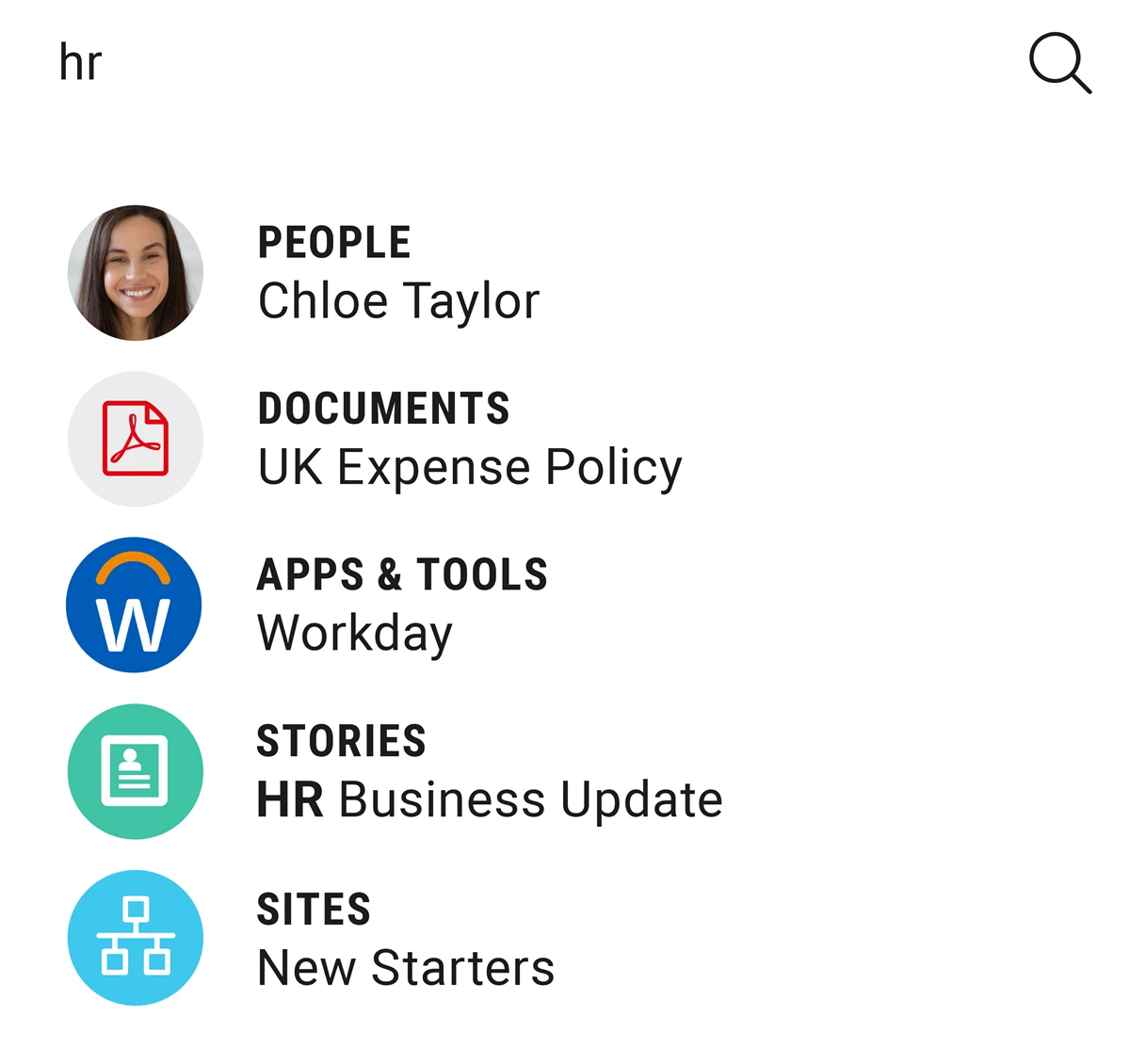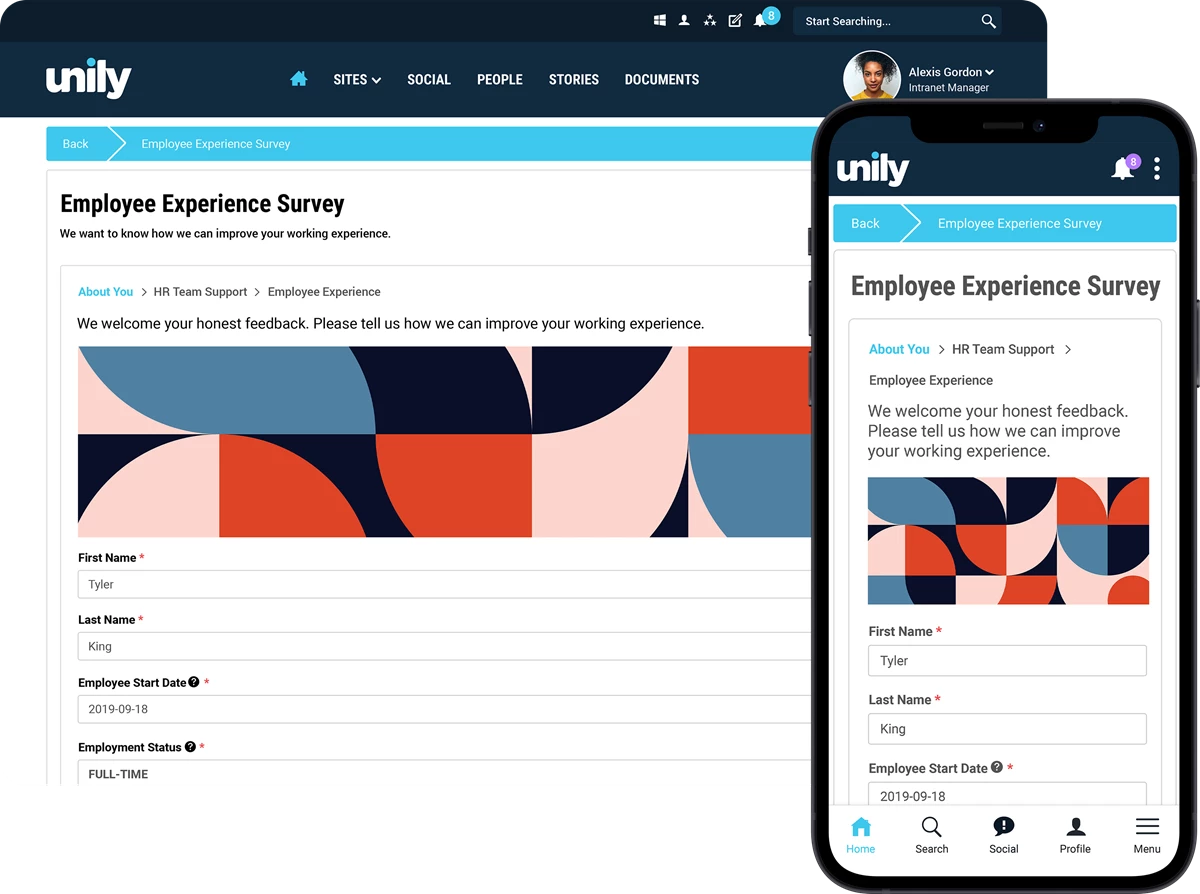Tackle employee experience at large with a platform for HR that unites your people, fuels your culture, and supports your teams to be more effective and productive. Streamline onboarding, integrate your HR systems, master compliance, and drive a self-service approach that empowers employees with the tools and information to thrive at work.
Communicating with employees is vital to any HR team, create and push relevant content to the right employees at the right time, allowing you to deliver a truly personalized experience for the user. Advanced targeting ensures that HR communications reach the relevant staff. Your organization can also opt for a social platform which allows public & private opt-in channels. Whether it's teams discussing a project, or all-company recipe sharing, it’s a real opportunity to curate and communicate your corporate culture across the organization, increasing staff motivation.
See how Adecco is changing the face of recruitment with a Unily intranet.
Attract the best of the best with innovative digital experiences that represent your brand and drive home your culture. An efficient recruitment process is extremely important for both internal and external vacancies. Promote internal mobility with dedicated widgets and keep employees connected with a business vision that unites and inspires. Our streamlined HR intranet platform allows your organization to communicate job vacancies quickly and easily and set up efficient applications forms.
Give new hires an onboarding experience that inspires them from the outset and primes them for success. Target experiences that move them through initial phases, collate relevant documentation in one place, trigger workflows that show them what to do next, and keep them connected with access to news, colleagues, and events.
"It is the first time we've had the entire intranet actually on mobile, not just a subset of it, and it's well organized so you don't get lost and you can actually find what you need. I've worked on intranets off and on for a long time and I've never seen a mobile experience this strong before."
"People want short, quick, real-time communications. That didn't exist before, today it's instant."
"By providing this new, mobile Unily intranet solution to our 44,000 colleagues, we are helping them to connect and communicate more effectively, which ultimately means a more consistent, high-quality service delivered to customers."
"Unily’s implementation team has been top-notch and their customer service has been very responsive. Employees love the look and feel of our new intranet."

"Unily fit our vision and met our strict security protocols on the backend. We’re very excited to be working with Unily to design an intranet that will enable our employees to feel more connected."
"As our colleagues are used to using Facebook, Twitter, and so on - to have the same great user experience with an internal tool is a gift for them."
"We wanted an enhanced intranet platform at Baker Hughes, which would improve our ability to communicate with our employees in real-time and in new ways. We have engaged Unily to help our employees navigate through change and drive results globally."
"The last 12 months have been a record-breaking success for our organization, and it is no coincidence that the growth we are seeing as a business is happening in parallel with our industry-leading engagement program."
"Before Unily, our digital workplace was essentially useless. No one went there for anything, and it was not used as a communication channel at all. Because of this, we had no way to get content out to employees who needed it, and it took employees 50% longer to find the information they needed to get their job done – if they could find it at all. This led to people going to ‘who they knew’ rather than getting the official information from the intranet."
"Unily has great search capabilities, contemporary design, is viewable on any device and soon will allow us to reach employees in our distribution centers, labs, and transport networks for the first time. It’s a real game changer for us."
"The Unily platform allows our employees to access relevant content more quickly, choose how and when they stay informed and take advantage of opportunities to collaborate more effectively with colleagues."
"Unily enables colleagues to stay up to date, share knowledge and collaborate, and ultimately helps us work smarter as we seek to continue to innovate and grow as a business."
"Working closely with Unily, we were able to design and implement an intranet solution that has improved usability, accessibility and navigation for our employees across the country. This has been especially important since the outset of the COVID-19 pandemic."
"Our intranet has a high degree of engagement and readership - we're really seeing our community come alive."
"Our ambition was to design a system that would significantly reduce the time our clinical teams spend locating the apps and information they need at their fingertips. The Unily system surpassed these requirements and has transformed the digital workplace experience for our staff."
"Being well informed, collaborating, communicating with colleagues and effective search tools – these are central to our new intranet. "
Unily can deliver so much more than just a traditional HR intranet platform; we aim to create a platform at the core of your digital workplace. Integrate with third-party specialty tools to prevent platform switching and enhance the adoption of key systems. Unily is built on a flexible infrastructure, meaning we can quickly develop an out-of-the-box intranet platform tailored to your team’s specific needs and allow you to continue using the same applications your employees are already familiar with, such as Microsoft Office 365, Workday, Expensify and many more.
Cultivate a culture of appreciation with native reward and recognition features that put employee achievements front and center. Celebrate your culture with value-aligned recognition that maps to your ethos. Encourage peer-to-peer recognition with kudos and leaderboards that make sure no good deed goes unrecognized.
Support employee growth with an agile platform that lets you create learning portals that land. Aggregate training videos, collate key documents, integrate 3rd party portals and utilize quizzes for an intuitive experience that supports upskilling across the enterprise.
Unily’s intranet platform provides a central location for storing documents and sharing. An HR intranet needs to be well organized and easy to navigate to be as beneficial as possible to a business. Through Unily's smart search functionality employees can easily find relevant information, such as booking annual leave, submitting expenses claims, or appraisal forms. We also ensure that sensitive data hosted on your platform is protected. You can set up permission restrictions to ensure that only those that should have access to particular documents have access, making sure that any sensitive information remains confidential.
Unily’s platform supports employee feedback and efficient workflows. You can design simple forms, to gather information from employees and track their satisfaction quickly and efficiently. This means any issues raised by staff can be resolved quicker, increasing the motivation of employees and making them feel heard. With workflow automation, work flows from staff members and systems to the cloud and back easily. What were previously time-consuming tasks transform into efficient processes, so your team concentrate on other more important responsibilities.

























